How to Identify a Turtle
In the quest for the identification of turtles, it’s interesting to note the differences in shell characteristics. For instance, the center of the shell or the carapace length can vary significantly among different species, such as the only sea turtle with a hard shell, the olive ridley turtle.
Turtles are among the most loved pets in the world and there are countless species of them from huge sea turtles to freshwater turtles and finally land turtles, also known as tortoises.
These turtles have a huge array of needs with different types of turtles having different needs. Turtles eat a wide variety of foods and require a wide variety of environmental conditions to thrive.
Identifying one turtle from another is essential if you want to care for them. Turtle identification will help you care for your turtle. You can always see a herp vet if you are still unsure.
Quick Reference Section
Table of Contents
Types of Turtles
In North America, species like the eastern mud turtle, with its distinctive yellow stripes, and the large-headed alligator snapping turtle are common. Further south, in the eastern United States, you might encounter musk turtles or the unique Florida softshells.
Freshwater Turtle
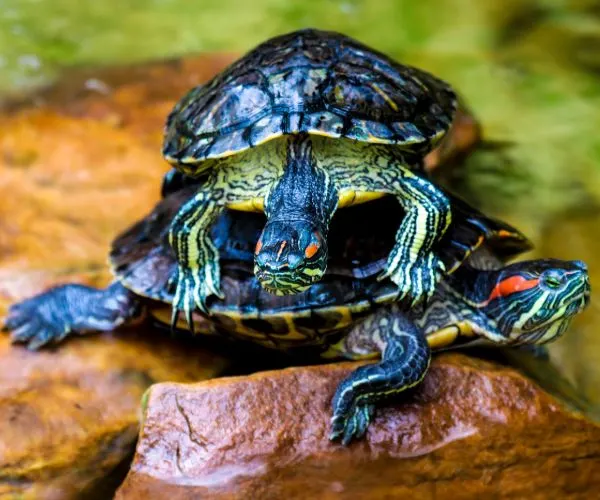
Most turtles you would come across are freshwater turtles. Freshwater turtles are generally smaller as compared to other turtles. These turtles are generally aquatic or semi-aquatic and spend most of their time in aquatic environments.
Apart from box turtles, which spend less time in the water, all other freshwater turtles spend most of their time in water. Some such as the Japanese pond turtle can spend months at the bottom of a pond or stream.
Examples include snapping turtles, cooters, softshell turtles, sliders, box turtles, wood turtles, and map turtles.
Sea Turtles
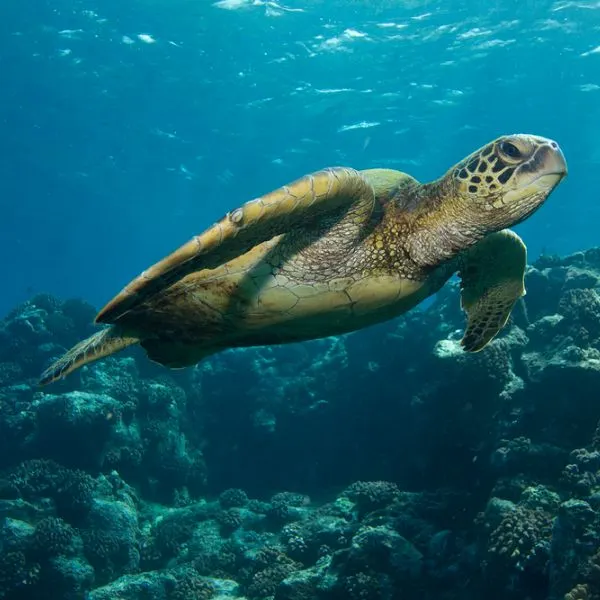
These can be found in the sea. They are generally large turtles and are generally purely aquatic. They do come to shore to lay eggs. The most telling feature of this type of turtle is its flippers. Instead of feet, sea turtles have flippers.
Examples of sea turtle species include the green turtles, kemp’s ridley turtles, loggerhead turtle, and the leatherback turtles, each with distinct features aiding in identification.
Land Tortoise
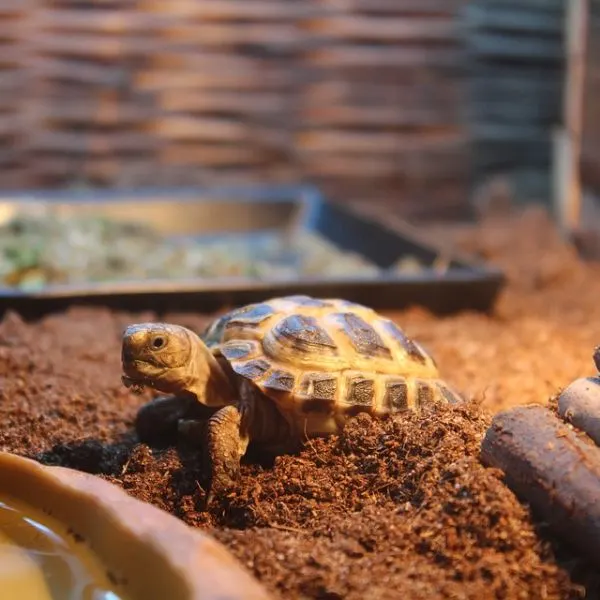
These are exclusively found on land. They have high domes, and their shells are generally heavier and less streamlined. Identify a tortoise by inspecting the feet. They have short, elephantine legs. When land tortoises move, they walk on their toes.
Examples of land tortoises include the gopher tortoise, a native of the western hemisphere, the ornate box turtle, the eastern box turtles, and the Asian box turtles like the Chinese box turtles, reflecting a diverse population structure.
Follow These Steps to Identify a Turtle
If you have pet turtles, knowing how to identify a turtle is a must. To best identify the turtle species, strictly follow the steps.
1. Identify If The Turtle Is A Freshwater Turtle, A Tortoise Or A Sea Turtle.
- If the front limbs are flippers, then this is a sea turtle. They are large and rare to come across as they spend most of their lives in the sea. (Move to section 15, which is a section on identifying sea turtles.)
- If the front limbs are not flippers but instead toes (be it webbed or not), then the turtle is either a tortoise or a freshwater tortoise. (Move on to the next section.)
- Tortoises walk on their toes while turtles walk on the flat of their feet. Turtles have flat feet while tortoises have elephant-like clawed feet.
2. Inspect The Plastron Shape
- If the turtle has a plastron which covers most of its underside, and a short tail which isn’t saw-like then it isn’t a snapping turtle. (Move on to the next section to better identify it.)
- The common snapping turtle (Chelydra serpentina) has a small cross-shaped plastron which covers just a tiny part of the underside. This plastron is about half of the shell. The snapping turtle is quite large turtles with carapace lengths of 8 to 18.5 inches. The snapping turtle also has a long saw-like tail.
3. Inspect The Shell
- If the shell/carapace is pliable and soft and the snout is elongated, then it is a softshell turtle.
- If the shell is hard, then it is not a softshell turtle. Move on to the next section.
4. Inspect The Scutes On The Shell
Scutes cover the turtle’s shell. They are composed of keratin.
- If the turtle has 12 scutes, continue to section 6.
- If the turtle has 11 scutes, continue to section 5.
5. Inspect The Pectoral Scute On The Plastron
- If the pectoral scute is squarish, and there is visible skin between the scutes, then it is a musk turtle.
- If the pectoral scute is triangular, and there is no visible skin between the scutes, then this is a mud turtle.
6. Inspect The Feet
- If the toes are webbed, and the plastron isn’t hinged, refer to the next section.
- The eastern box turtle has 12 scutes and elephant-like feet. The toes are not webbed and the plastron is hinged allowing the turtle to be completely enclosed in its shell. The scientific name of the eastern box turtle is Terrapene carolina carolina. Although, they are pond turtles, don’t spend as much time in water as compared to other freshwater turtles.
7. Inspect The Keel
- If the carapace of the turtle is not sculptured with a central keel consisting of a pyramidal pattern of grooves and ridges, then refer to the next section. Also, inspect the tail of the turtle if it’s a hatchling. If its tail is shorter than the carapace, definitely move on to the next section.
- The wood turtle (Glyptemys insculpta) has a carapace that is flat and sculptured, its central ridge or keel is composed of a pyramidal pattern of grooves and ridges. The coloration of this turtle’s plastron is yellow with black spots on the corners of the scutes underneath the turtle. The tail of the hatchling is as long as its carapace.
8. Inspect The Length Of The Neck.
- If the head and neck can stretch to be as long as or even longer than the plastron then you have a chicken turtle (Deirochelys reticularia).
- If the stretched length of the neck and head is less than the length of the plastron, then it’s not a chicken turtle.
9. Inspect The Carapace
- If the carapace has concentric grooves and brown concentric circles on the scutes, then it may be a terrapin, also known as the diamondback terrapin (Malaclemys terrapin). This species also have several black spots on the soft grayish skin of the head, neck, and legs.
- b. If the carapace features mentioned in (a) are not available and the kegs are stripped or without marks, refer to the next section.
10. Inspect The Carapace Again
- If the carapace has a serrated edge and saw-like vertebral keel it may just be a map turtle (Graptemys spp). The red-eared slider also has serrated edges. Move on to section 13 to learn more.
- If the carapace is smooth rather than serrated, then it may be an Eastern Painted Turtle (Chrysemys picta picta), Spotted Turtle (Clemmys guttata), or a Bog Turtle (Glyptemys muhlenbergii). Move on to section 11.
11. Inspect The Jaws
- If the jaw features mentioned are absent and the carapace has spots instead refer to section 12.
- The eastern painted turtle has an upper jaw that is notched with small cusps on either side. Similarly, you will notice reddish-orange lines that go across the carapace.
12. Inspect The Carapace Once Again
- If the turtle lacks a keel, has an orange patch underneath the eye, and has a black carapace with yellow or white spots then it may be a spotted turtle (Clemmys guttata).
- If the carapace has a keel and is brown without markings, this turtle may be a bog turtle. The bog turtle also has a reddish-orange spot pm the neck and head.
13. Inspect The Head And Neck
- If the stripes on the neck are fewer than 16, then it may be a slider or cooter. There are several sliders including the Cumberland slider, the Yellow-bellied Slider, and the red-eared slider. Move to the next section to narrow down the type of cooter or slider you have.
- Map turtles (Graptemys spp) have stripes (over 15) on their head and neck as well as a small yellow patch behind their eyes. They also have lines on their carapace which resemble contours thus the name Map turtle.
Identifying Sliders And Cooters
Sliders have a midpoint notch in the marginal scutes at the posterior.
Sliders
Cumberland Sliders
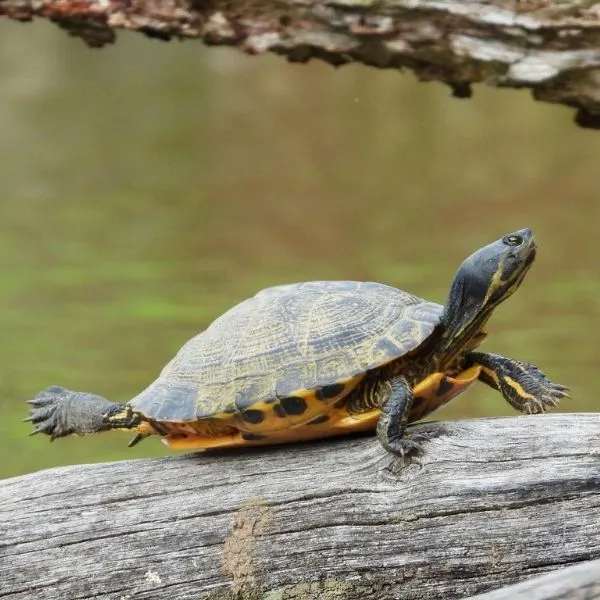
The Cumberland slider has an olive-green to brownish carapace with yellow markings.
Yellow Bellied Sliders
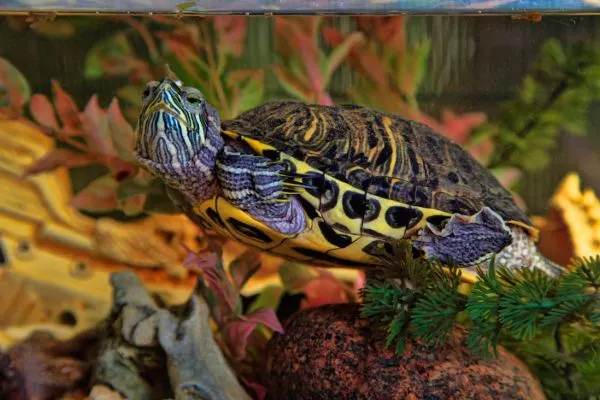
The yellow-bellied slider has a solid yellow plastron. Thus the name yellow-bellied.
Red-eared Sliders
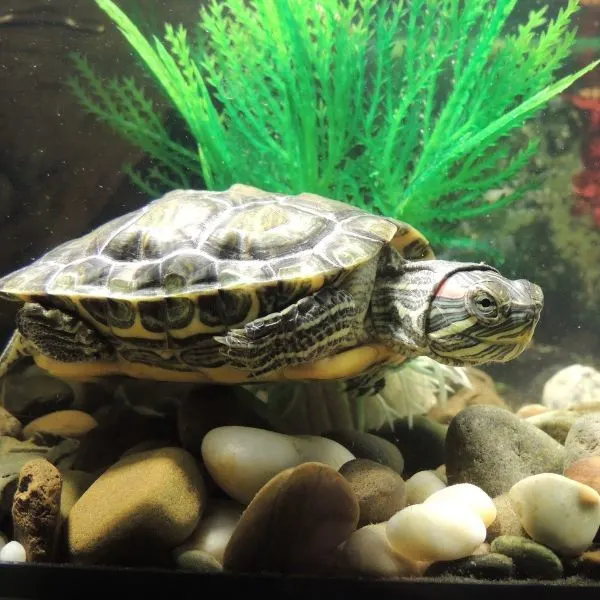
Red-eared sliders have a red patch behind their eyes. This looks like a red ear.
Cooters
The neck and head of cooters feature yellowish-white stripes and the marginal scutes of the posterior aren’t notched midpoint.
Northern Red-Bellied Cooter

The northern red-bellied cooter (Pseudemys rubriventris) has a red (or reddish-orange) plastron. The edges of the plastron are usually redder forming a red margin around the plastron. The carapace is brown or black with traversal yellow and orange stripes.
Eastern River Cooter

The eastern river cooter (Pseudemys concinna concinna) has a greenish-brown with a ‘c’ mark that faces the posterior. It also has about 11 or more stripes on the head and necks. The plastron is reddish-orange to yellow with dark lines between the scutes that fade with age.
Coastal Plain Cooter

The coastal plain cooter (Pseudemys concinna floridana) has 10 or fewer stripes on the head and neck. The plastron of this species is yellow and lacks any patterns.
African Sideneck Turtle
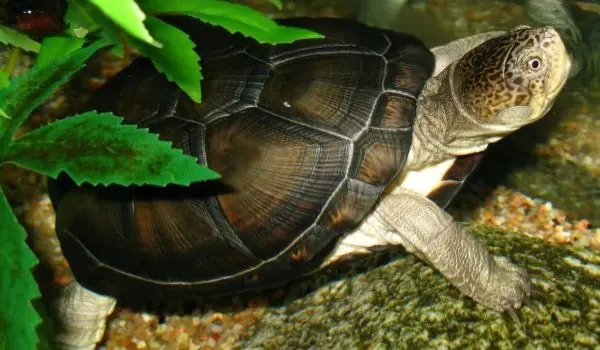
African Sideneck turtles (Pelusios castaneus) have gray underbellies with black accents and relatively flat shells that are dark green or brown.
Identifying Sea Turtles
Below is a Sea turtle identification chart to summarize what to look for in each species. Below the chart are pictures as well to give a more clear understanding.
| Type | Description |
| Green | They have a rounded head, greenish-black coloration, smooth domed carapace with teardrop shape |
| Hawksbill | They have a narrow head and beak, are yellowish-brown in coloration, and a mottled carapace with overlapping scutes |
| Leatherback | They have a Blunt head with a visible pineal gland or ‘pink spot’, are grayish-black with white patches, and have a leathery carapace with 7 ridges |
| Loggerhead | They have a broad head with yellow cheeks and a redish-brown heart-shaped carapace |
| Olive Ridley | Like the Kemp’s Ridley, they have a triangular head. Their cheeks are a light grayish-olive coloration, and finally a rounded carapace |
| Kemp’s Ridley | They have a triangular-shaped head with a slightly hooked beak. Baby turtles will be darkly colored on both sides. |
| Flatback | Flatback sea turtles have a unique appearance with greenish or olive-shaded flippers and pale undersides. |
Leatherback Sea Turtle
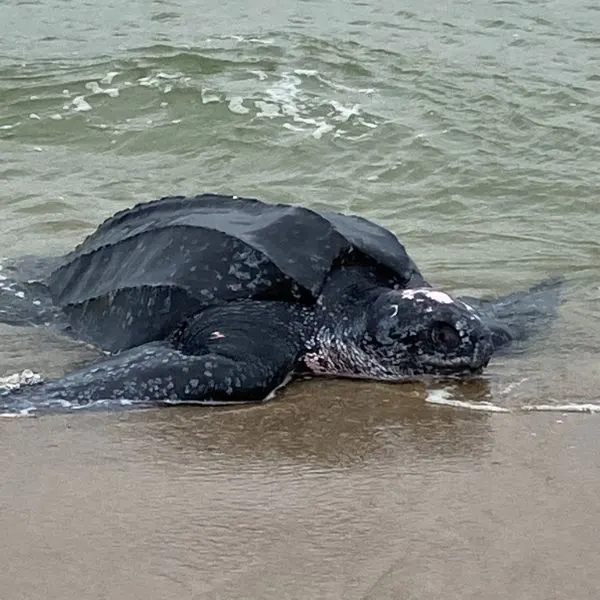
If the sea turtle has no scutes, then it is a leatherback sea turtle (Dermochelys coriacea).
Kemp’s Ridley Sea Turtle
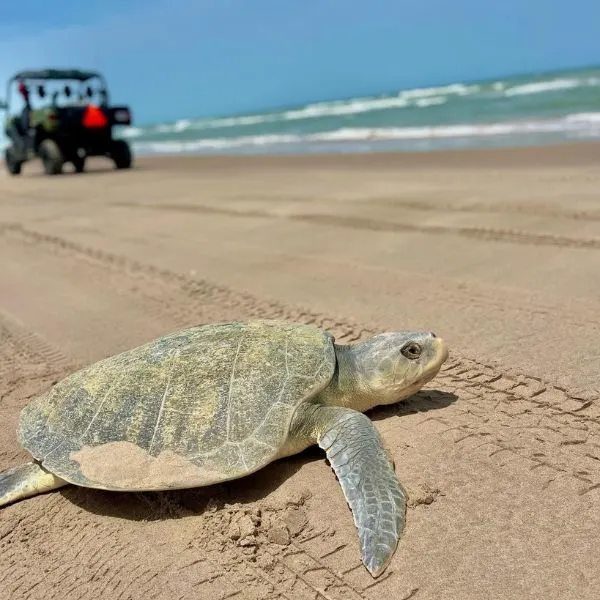
If the sea turtle has five pleural scutes and a squarish first vertebral scute with pores in its bridge scutes and four or five inframarginal scutes, it is the Atlantic ridley sea turtle (Lepidochelys kempii).
Green Sea Turtle
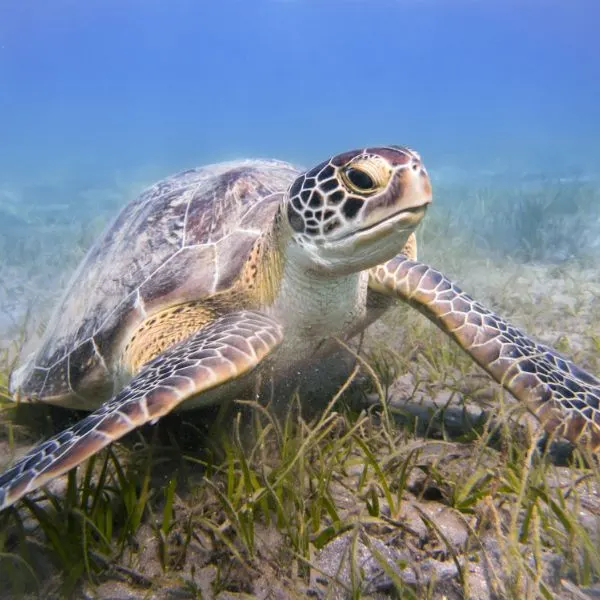
If the sea turtle has four pleural scutes and a triangular first vertebral scute with one pair of prefrontal scales on its head then it is the endangered black/green sea turtle (Chelonia mydas).
Hawksbill Sea Turtle

If the sea turtle has four pleural scutes and a triangular first vertebral scute with two pairs of prefrontal scales on its head then it is the critically endangered hawksbill sea turtle (Eretmochelys imbricata).
Loggerhead Sea Turtle
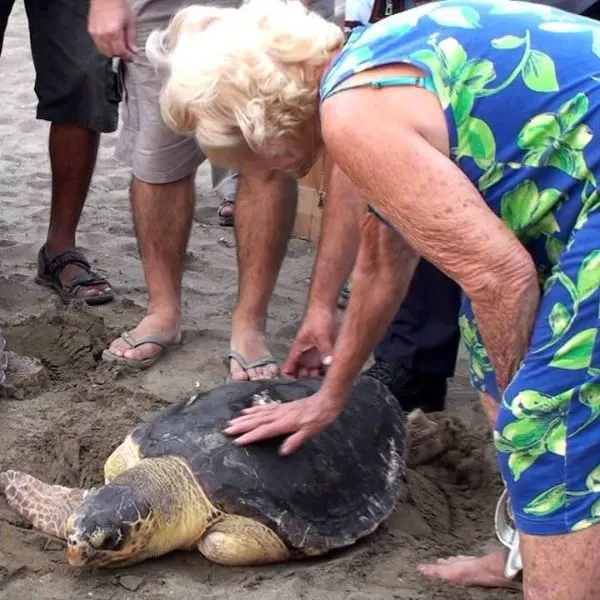
If the sea turtle has five pleural scutes and a squarish first vertebral scute with a large ovoid plate on its dorsum, and four or three inframarginal scutes on it bridge, then its a loggerhead sea turtle(Caretta caretta).
Identifying Land Tortoises
Land tortoises unlike their aquatic cousins (turtles) prefer to dwell on land. Unlike aquatic turtles, tortoises aren’t adapted to living in water. They are poor swimmers and have heavier shells.
Likewise, their feet are short and sturdy instead of webbed like most freshwater turtles. All of these characteristics make them better suited for the land.
There are several tortoise species in the world. Currently, there are about 50 tortoise species alive. Hopefully, the number doesn’t fall in the coming decades and even centuries. With so many tortoises alive, we can’t cover them all. We will be covering the most popular species.
Identifying A Spurred Tortoise And A Greek Tortoise

These tortoises have pointed scutes on their carapaces. These look like spurs. They are about 3 ft long and have brownish shells. As you can see, spurred tortoises are large. In the wild, they are endemic to Sub Saharan Africa.
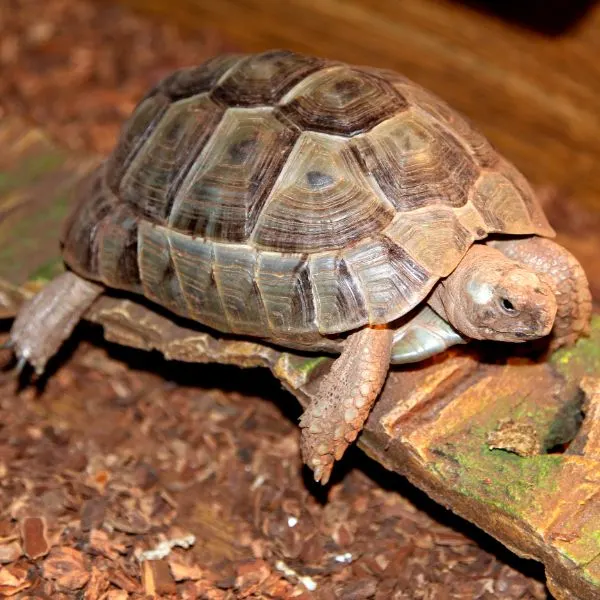
Greek tortoises (Testudo graeca) also have pointed scutes on their carapaces. However, unlike the spurred tortoises, the Greek tortoises grow to be about only 7 inches. Their shell is also olive-green instead of brown.
Identifying A Russian Tortoise

Russian tortoises are about 8 inches long. They have round shells and brownish-black scutes. The lines in-between their scutes are yellow. This contrasts with their black coloration. Watch out for the contrasting yellow and black coloration when identifying a Russian tortoise.
Identifying A Indian Star Tortoise

Indian tortoises have a star pattern on each of their carapace scutes. Their scutes are pointed with white/yellow lines connecting the edges of the scute to the center. They are also about 8 inches long.
Identifying A Red-Footed Tortoise
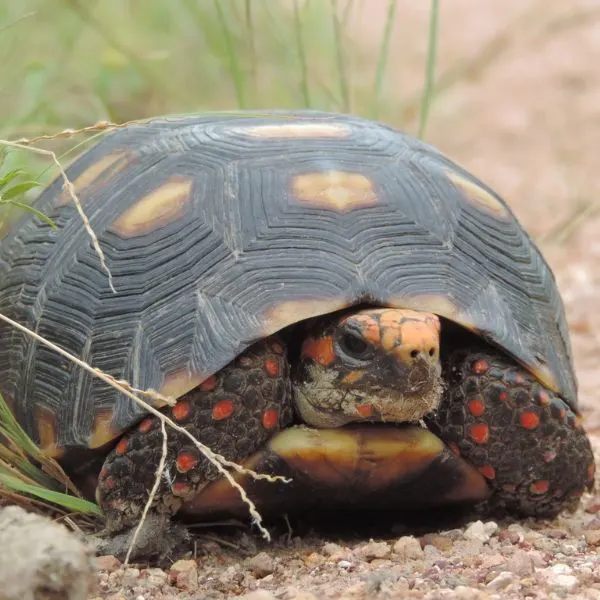
The red-footed tortoise has red markings all over the feet. The red spots can also be found on the face. The carapace is black with yellow coloration. They are native to South American but they are also found all over the world as pets. They are generally 11 to 14 inches long.
Identifying A Hermann’s Tortoise

The easiest way to identify the Hermann’s tortoise is to note the brown and yellow coloration. They are about 5 to 7 inches long. Their shell is darkly colored with yellow lines in between the scutes. There are yellow spots all over their brownish skin.

Conclusion
Turtle identification, an effective tool for understanding and protecting these creatures, is important. It can be a difficult task unless you know what you are doing. While we are unable to provide a means to identify all 300 turtles currently living, we have provided identification methods for the most popular turtles in the world.
Before we leave you, we would like to remind you that sea turtles have flippers for limbs, freshwater turtles have flat feet, and land tortoises have clawed elephantine feet.
I hope this article helps you answer the question, ‘What type of turtle do I have?’ If you have any comments, kindly leave them. Thanks.
More cool turtle stuff

Michelle
Monday 1st of January 2024
Please help identify this baby turtle. Found in northern NSW, Australia. Would like to add photos.
Michele
Tuesday 27th of June 2023
I have a painted turtle. What else are they called?
Jeanie Moore
Wednesday 21st of June 2023
I had a red footed tortoise come into my back yard yesterday evening. I had never seen anything like it. I have no idea where it came from. I should have kept it but I was so shocked, I just took some pictures on my phone and let it go into the tall weeds. I just identified it by the pictures above. I am in Arkansas
Lessiehall
Sunday 5th of March 2023
Please tell me what kind of turtle this is and what can he eat please
Bob
Friday 19th of August 2022
Assumption you make is we know the general anatomical parts. More helpful to have a section at the beginning with a pro-typical turtle, identifying the parts. I'm trying to identify a turtle from a photo; this was no help at all.